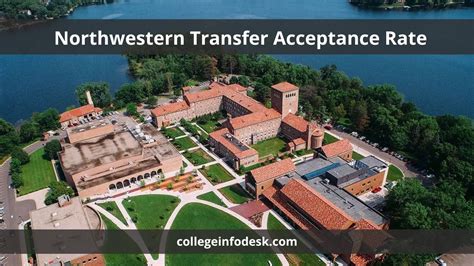Introduction

Northwestern University, renowned for its academic excellence and research prowess, attracts countless aspiring students seeking admission as transfer applicants. Understanding the university’s acceptance rate is crucial for aspiring transfer students to gauge their chances of admission. This comprehensive guide delves into the intricacies of Northwestern’s transfer admissions process, providing valuable insights into the university’s selectivity and the factors that influence its acceptance rate.
Northwestern Transfer Acceptance Rate
According to the latest data from the National Center for Education Statistics (NCES), Northwestern University’s transfer acceptance rate for the 2021-2022 academic year stood at 13%. This figure represents a highly competitive admissions process, emphasizing the need for transfer applicants to present exceptional academic credentials and compelling personal statements.
Influencing Factors
The Northwestern University transfer acceptance rate is influenced by a combination of factors, including:
- Academic Record: As a leading research institution, Northwestern places paramount importance on academic performance. Transfer applicants with superior GPAs, rigorous coursework, and strong standardized test scores increase their chances of admission.
- Institutional Alignment: Transfer applicants who have attended highly reputable institutions with academic offerings that align with Northwestern’s academic programs may have an advantage in the admissions process.
- Course Articulation: Applicants must ensure that their previously completed coursework aligns with Northwestern’s requirements. Strong articulation between institutions can enhance the transferability of credits and support the student’s academic success at Northwestern.
- Extracurricular Activities: Northwestern values students who actively engage in extracurricular activities. Involvement in clubs, organizations, and community service demonstrates well-roundedness and a commitment to making a positive impact.
- Personal Statement: The personal statement provides transfer applicants with an opportunity to share their motivations, aspirations, and contributions they hope to make to the Northwestern community. A well-written personal statement can significantly bolster an application.
Common Mistakes to Avoid
To optimize their chances of admission, transfer applicants should avoid common pitfalls:
- Incomplete Application: Submit a comprehensive application that includes all required documents, including transcripts, standardized test scores, and personal statement.
- Inaccurate Information: Ensure all information provided in the application is accurate and complete. Discrepancies can raise red flags and hinder the admissions process.
- Lack of Planning: Start the transfer process early to allow ample time for research, course articulation, and the application process.
- Underestimating the Competition: Do not underestimate the competitiveness of Northwestern’s transfer admissions process. Prepare a strong application that showcases your academic abilities and personal qualities.
- Ignoring Deadlines: Submit the application by the specified deadline. Late submissions may result in disqualification from the admissions process.
FAQs
- What is the average GPA for transfer applicants admitted to Northwestern?
Typically, admitted transfer applicants have GPAs of 3.7 or higher.
- Do transfer applicants need to submit standardized test scores?
Yes, most transfer applicants are required to submit either ACT or SAT scores.
- When is the deadline for transfer applications?
Northwestern University has rolling admissions for transfer applicants. The priority deadline for fall enrollment is March 1st.
- What are the most popular majors for transfer students?
Some of the most popular majors for transfer students include economics, political science, computer science, and engineering.
- What are the best ways to increase my chances of admission?
Maintain a strong academic record, engage in meaningful extracurricular activities, and craft a compelling personal statement.
- How can I prepare for the transfer process?
Research Northwestern University’s academic programs, articulate your coursework, and start the application process early.
Conclusion
Northwestern University’s transfer acceptance rate underscores the university’s selectivity and the competitive nature of its admissions process. Aspiring transfer students should prepare a strong application that demonstrates their academic excellence, extracurricular involvement, and personal qualities. By understanding the influencing factors and avoiding common mistakes, transfer applicants can improve their chances of admission to this prestigious institution.
Additional Resources
